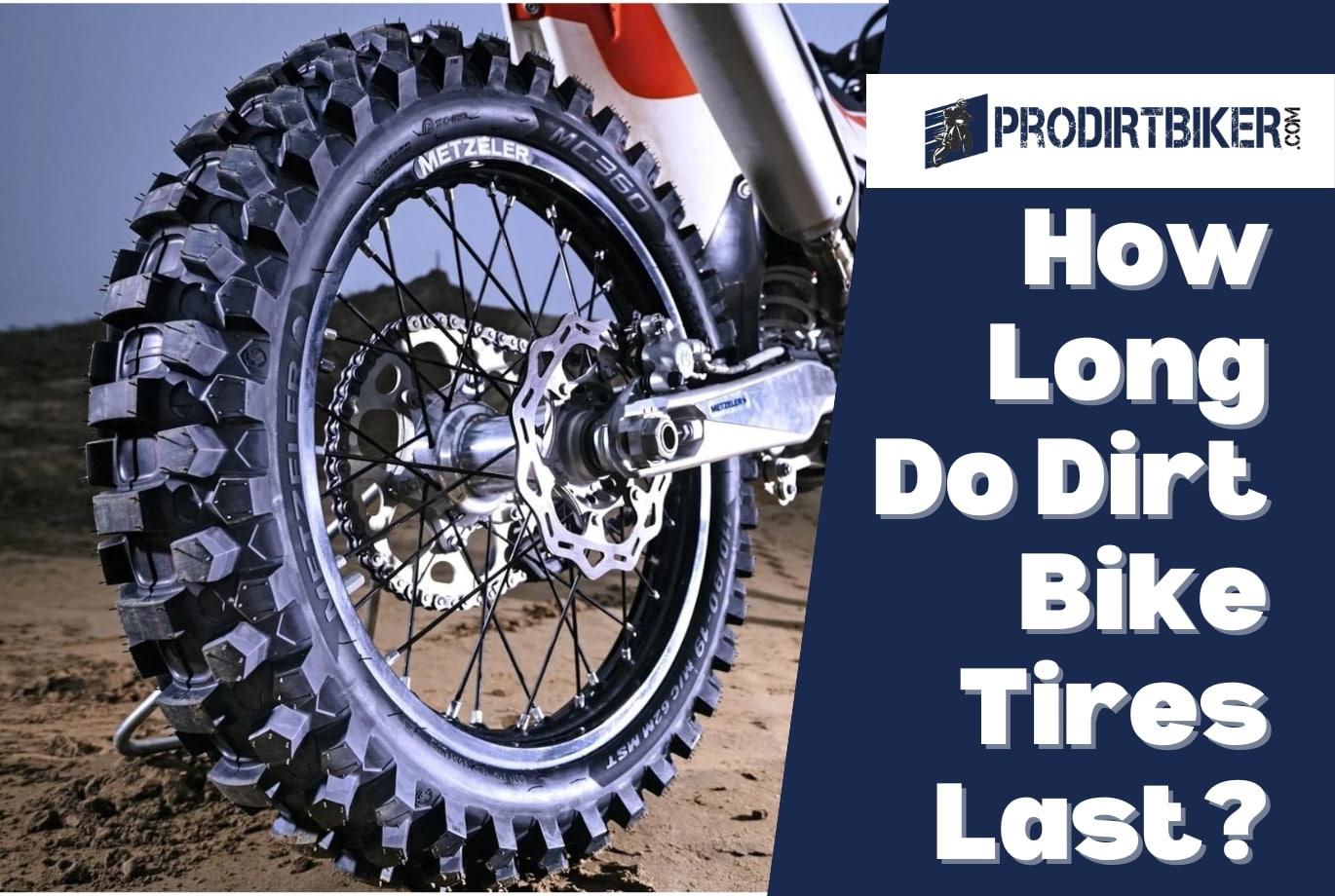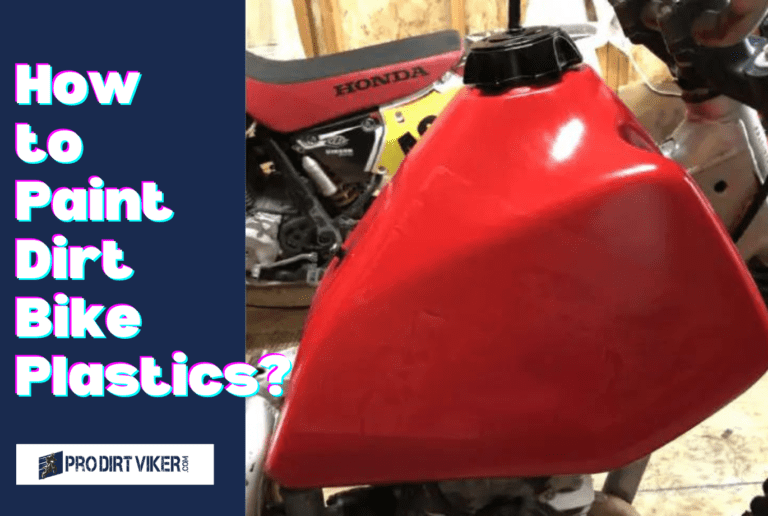How Long Do Dirt Bike Tires Last? Expert Tips and Advice

Dirt bike tires typically last around four to five years, as their flexibility and ability to grip diminishes with age. It is important to replace them after this period to ensure safety and optimal performance.
Factors Affecting The Lifespan Of Dirt Bike Tires
Proper tire maintenance and care
Proper tire maintenance and care play a crucial role in extending the lifespan of dirt bike tires. By following a few simple steps, you can ensure that your tires stay in optimal condition for a longer period.
- Regularly check tire pressure: Make sure to check your tire pressure before every ride. Underinflated or overinflated tires can cause excessive wear and decrease the overall lifespan of your tires.
- Inspect tires for damage: Before each ride, inspect your tires for any signs of damage such as cuts, punctures, or bulges. If you notice any damage, it’s important to replace the tire to avoid safety risks.
- Rotate tires: Regularly rotating your tires can help distribute the wear more evenly, allowing them to last longer. Refer to your bike’s manual for the recommended tire rotation pattern.
- Clean tires: Keeping your tires clean is essential for maintaining their performance. Use mild soap and water to remove dirt and debris, and avoid using harsh chemicals that can damage the tire material.
Frequency of riding
The frequency at which you ride your dirt bike can also impact the lifespan of your tires. The more often you ride, the quicker your tires will wear out. Consider the following tips to maximize the lifespan of your tires:
- Ride responsibly: Avoid unnecessary spinning, skidding, and burnouts as these actions can significantly reduce tire life.
- Plan your rides: If possible, plan your rides to minimize excessive wear and tear on the tires. Vary your routes and adjust your riding style according to the terrain.
- Tire selection: Opt for high-quality tires that are specifically designed for the terrain you frequently ride on. Different tires are suited for different conditions, and choosing the right ones can extend their lifespan.
Terrain and riding conditions
The type of terrain and riding conditions you frequently encounter can have a significant impact on the lifespan of your dirt bike tires. Here are some considerations to keep in mind:
- Know your terrain: Different terrains, such as mud, sand, or rocky trails, can vary in their level of tire wear. Adjust your riding style and tire selection accordingly to minimize the wear and tear.
- Riding style: Aggressive riding on rough terrains can cause excessive tire wear. Try to maintain a smooth and controlled riding style to extend the life of your tires.
- Weather conditions: Extreme weather conditions, such as high heat or freezing cold, can also affect tire performance. Ensure to choose tires that are suitable for the weather conditions you typically ride in.
By paying attention to proper tire maintenance and care, the frequency of riding, and the terrain and riding conditions, you can significantly extend the lifespan of your dirt bike tires. Remember to regularly inspect, clean, and adjust your tires, and choose high-quality tires suitable for your riding style and terrain.
Signs That Indicate Dirt Bike Tires Need To Be Replaced
As a responsible dirt bike rider, it’s crucial to know when to replace your tires to ensure your safety on the trails. Over time, dirt bike tires will inevitably wear down and lose their performance capabilities. Here are some key signs to look out for that indicate your dirt bike tires need to be replaced:
1. Worn-out tread pattern
One of the most obvious signs that indicate it’s time to replace your dirt bike tires is a worn-out tread pattern. The tread pattern plays a vital role in providing grip and traction on various surfaces. As you put more hours on your tires, the knobs on the tread will start to wear down, causing a loss of traction. If you notice that the tread pattern has become significantly shallow or smooth, it’s time to invest in a new set of tires.
2. Loss of grip and traction
Grip and traction are crucial for maintaining control and stability while riding your dirt bike. If you find that your bike slips or slides more frequently, even on surfaces where it typically had good traction before, it’s a strong indication that your tires have lost their grip. This loss of grip can occur due to worn-out knobs or insufficient softening of the rubber compound. In such cases, replacing your tires will restore the necessary grip and enhance your riding experience.
3. Cracks or bulges on the sidewall
Inspecting the sidewalls of your dirt bike tires is equally important when assessing their condition. Cracks or bulges on the sidewall can be indicative of internal damage, such as weakened cords or a compromised structure. If you notice any visible signs of damage on the sidewall, it’s crucial to replace the tires immediately. Riding on damaged tires can lead to blowouts or sudden loss of air pressure, jeopardizing your safety on the trails.
4. Uneven tread wear
Another sign that it’s time to replace your dirt bike tires is uneven tread wear. Uneven wear can occur if the tire is improperly balanced or if the suspension needs adjustment. It’s essential to regularly inspect your tires to ensure the tread wears evenly across the entire surface. If you notice significant differences in tread wear between different areas of the tire, it’s a clear indication that it’s time for a replacement.
By keeping an eye out for these signs and regularly inspecting your dirt bike tires, you can ensure that you’re always riding on safe and reliable rubber. Remember, replacing your tires at the right time is essential for maintaining optimal performance and maximizing your riding pleasure.
Tips For Increasing The Lifespan Of Dirt Bike Tires
When it comes to dirt biking, the lifespan of your tires plays a crucial role in your overall riding experience and safety. To get the most out of your dirt bike tires and avoid unnecessary replacements, it’s essential to follow some simple maintenance tips. In this section, we’ll walk you through the key factors that can increase the lifespan of your dirt bike tires, ensuring you have a smooth and enjoyable ride for longer periods. Let’s dive right in!
Choosing the right tire for your riding style
Choosing the right tire for your dirt bike and riding style is the first step towards increasing their lifespan. Different terrains require specific tire types, such as soft, intermediate, or hard compound tires. Soft compound tires are perfect for muddy and loose terrains, whereas hard compound tires offer better durability on hard-packed surfaces.
Additionally, consider the tire’s tread pattern. Aggressive knobs are suitable for off-road adventures, while less aggressive ones are better for on-road riding. By selecting the most suitable tire for your riding style, you can ensure optimal traction, durability, and performance, ultimately extending the lifespan of your dirt bike tires.
Proper tire inflation and pressure checks
Proper tire inflation is vital for maximizing the lifespan of your dirt bike tires. Incorrect tire pressure can lead to uneven wear, decreased traction, and increased risk of punctures. Therefore, it’s crucial to regularly check your tire pressure and maintain it within the manufacturer’s recommended range.
To check the tire pressure, use a reliable tire pressure gauge and compare the reading with the recommended pressure stated in the owner’s manual or on the tire itself. If the pressure is too low, it can cause the tire to flex excessively, leading to faster wear. On the other hand, overinflated tires can result in a harsh ride and increased vulnerability to impacts.
Regular inspection and cleaning
Regularly inspecting and cleaning your dirt bike tires is another essential step in extending their lifespan. Inspect the tires for signs of wear, including worn-out knobs, cracks, punctures, or any other damage. Any significant wear or damage should prompt immediate replacement.
Cleaning your dirt bike tires after each ride is equally important. Keep them free from debris, mud, and other contaminants that can accelerate wear. Using a gentle brush and mild detergent, thoroughly clean the tires and ensure they are completely dry before storing the bike. Regular inspection and cleaning will help maintain the tires’ performance and identify any potential issues before they become major problems.
Avoiding excessive hard braking and acceleration
Excessive hard braking and acceleration can greatly impact the lifespan of your dirt bike tires. Abrupt stops and aggressive accelerations put extra stress on the tires, leading to increased wear and tear. To extend the lifespan of your tires, practice smooth and controlled riding techniques, gradually applying brakes and throttle when necessary.
Furthermore, avoid spinning the rear tire unnecessarily, as it can cause quick wear of the knobs. When riding on slippery or loose terrains, maintain a steady speed and use controlled acceleration to grip the surface effectively, minimizing tire wear.
By following these tips for increasing the lifespan of your dirt bike tires, you can enhance their durability, performance, and safety. Remember, proper tire selection, regular pressure checks, inspections, and gentle riding techniques are key to getting the most out of your dirt bike tires. Implement these practices into your maintenance routine and enjoy more worry-free and enjoyable rides!
Recommended Mileage For Replacing Dirt Bike Tires
Knowing when to replace your dirt bike tires is essential for maintaining your safety and optimal performance on the trail. While there isn’t a specific mileage limit for replacing dirt bike tires, there are some general guidelines that can help you determine when it’s time to swap them out for a fresh set.
Average lifespan of dirt bike tires
The average lifespan of dirt bike tires can vary depending on several factors, including the type of terrain you ride on, your riding style, and the specific tire model. On average, dirt bike tires can last anywhere from 20 to 40 hours of riding time. However, keep in mind that these estimates are just general guidelines and can vary depending on various factors.
Factors to consider when determining tire replacement
When determining whether it’s time to replace your dirt bike tires, there are a few factors to consider:
- Tread wear: Check the condition of your tire’s tread. If the knobs are worn down, flattened, or cracked, it’s a clear sign that your tires need to be replaced.
- Age: Even if your tires have low mileage, the age of the tire plays a role. Tires that are older than four to five years can start to lose their grip and become unsafe.
- Riding conditions: Riding on rough or rocky terrain can accelerate tire wear, shortening their lifespan. If you frequently ride in challenging conditions, you may need to replace your tires more frequently.
- Riding style: Aggressive riders who tend to push their bikes to the limits may experience faster tire wear compared to casual riders.
Expert guidance on tire replacement intervals
While there isn’t a hard and fast rule for when to replace dirt bike tires, experts generally recommend replacing them every 20 to 40 hours of riding time or at least once a year. However, it’s essential to regularly inspect your tires for signs of wear and tear and make a judgment based on their condition.
Expert Tips For Choosing The Best Dirt Bike Tires
Choosing the right dirt bike tires is essential for optimal performance and safety. However, with so many options available, it can be overwhelming to find the perfect fit for your riding style and terrain. To help you make an informed decision, we have compiled expert tips for choosing the best dirt bike tires. By understanding different tire types, tread patterns, and considering the balance between performance and durability, you can ensure that your dirt bike tires last long and provide the necessary grip and control on various terrains.
Understanding different tire types and their specific applications
When it comes to dirt bike tires, there are various types designed for different riding conditions. It’s important to consider the specific application and choose a tire that suits your needs. Here are the different tire types you should be familiar with:
| Tire Type | Application |
|---|---|
| Hard Terrain | Designed for compact, rocky terrains with minimal traction. These tires have a harder rubber compound for enhanced durability and resistance to wear. |
| Soft Terrain | Optimized for loose, sandy, or muddy terrains. These tires have taller and more widely spaced knobs for increased traction and self-cleaning capabilities. |
| All-Terrain | Versatile tires suitable for a variety of terrains. They strike a balance between durability and traction, making them a popular choice for riders who encounter a mix of conditions. |
| Intermediate Terrain | Designed for a range of intermediate conditions, including loam, hard-packed dirt, and loose rocks. These tires offer a good compromise between grip and durability. |
Tread pattern considerations for various terrains
One of the key factors to consider when choosing dirt bike tires is the tread pattern. Different terrains require specific tread patterns to optimize performance and grip. Here are some considerations for different terrains:
- For hard-packed terrains, look for tires with closely spaced knobs to increase traction on compact surfaces.
- For sandy or muddy terrains, opt for tires with widely spaced knobs to prevent clogging and improve traction.
- For rocky terrains, consider tires with reinforced sidewalls and durable knobs to withstand the rough terrain and provide enhanced grip.
- For a mix of terrains, choose tires with a versatile tread pattern that can handle a range of conditions.
Balancing performance and durability
When selecting dirt bike tires, it’s important to find the right balance between performance and durability. Tires that offer excellent grip and performance may wear out faster, while more durable tires may sacrifice some traction. Consider your riding style and the frequency of tire replacements you are comfortable with. It’s also crucial to regularly inspect your tires for signs of wear and replace them when necessary to maintain optimal performance and safety.
By understanding different tire types and their specific applications, considering the tread pattern for various terrains, and balancing performance and durability, you can make an informed decision when choosing the best dirt bike tires. Remember to always prioritize safety and replace your tires when they show signs of wear to ensure a safe and enjoyable off-road experience.
Maintaining And Storing Dirt Bike Tires During Off-Seasons
Proper maintenance and storage of dirt bike tires during off-seasons are crucial in maximizing their lifespan and performance. Dirt bike tires, just like any other tires, can deteriorate over time due to wear and tear, exposure to UV rays, and improper storage. In this section, we will discuss three important aspects of maintaining and storing dirt bike tires during the off-season: cleaning and removing debris before storage, proper tire storage techniques to minimize damage, and reconditioning and preparation before reinstalling.
Cleaning and Removing Debris before Storage
Before storing your dirt bike tires during the off-season, it is essential to clean them thoroughly and remove any debris that may have accumulated during rides. Follow these steps to ensure your tires are clean:
- Start by rinsing the tires with water to remove surface dirt and mud. Use a hose or a pressure washer for better results. Avoid using high-pressure water directly on the tires to prevent damage to the tread or sidewalls.
- Next, use a mild soap or tire cleaner specifically designed for off-road tires. Apply the cleaner to a soft bristle brush and scrub the tires gently. Pay attention to the tread pattern and sidewalls to remove any dirt or grime.
- Rinse the tires thoroughly to remove any soap residue, and pat them dry using a clean towel or let them air dry completely. Ensure that the tires are completely dry before storing to prevent moisture build-up, which can lead to mold or mildew growth.
- Inspect the tires for any signs of damage or wear, such as cuts, bulges, or worn-out tread. If you notice any significant damage or if the tread depth is below the manufacturer’s recommended limit, it may be time to replace the tires.
Proper Tire Storage Techniques to Minimize Damage
When it comes to storing dirt bike tires during the off-season, it is crucial to follow proper storage techniques to minimize damage and extend their lifespan. Consider the following tips:
- Store the tires in a cool, dry, and well-ventilated area to prevent excessive heat and humidity, which can accelerate tire degradation. Avoid locations exposed to direct sunlight or extreme temperature fluctuations.
- Keep the tires away from sources of ozone, such as electric motors or other machines that generate ozone, as ozone can cause rubber to deteriorate over time.
- If possible, elevate the tires off the ground using a tire rack or a wooden pallet to prevent flat spotting and deformation.
- When stacking tires, avoid placing heavy objects on top of them, as this can cause deformation and damage to the sidewalls.
- Ensure that the tires are stored away from chemicals, solvents, and petroleum-based products, as these can degrade the rubber compound.
- If you have multiple sets of tires, label them or maintain a record of their usage to rotate them regularly. This helps distribute the wear and prolong the overall lifespan of the tires.
Reconditioning and Preparation before Reinstalling
Before reinstalling your dirt bike tires after the off-season, it is important to recondition and prepare them to ensure optimal performance and safety. Follow these steps:
- Inspect the tires for any signs of damage or wear, such as cracks, cuts, or uneven wear pattern. Replace the tires if necessary.
- Check the tire pressure and adjust it according to the manufacturer’s recommended specifications. Underinflated or overinflated tires can affect handling, traction, and overall performance.
- If the tires have been stored for a long period, the rubber compound may have become stiff. To restore flexibility, gently knead the sidewalls or apply a tire conditioner recommended by the tire manufacturer.
- Mount the tires properly onto the rims, ensuring that they are aligned correctly and balanced. Improper mounting can lead to uneven wear and compromised stability.
- Once the tires are properly installed, take a few minutes to warm them up before hitting the trails. This helps the tires regain their optimal grip and performance.
By following these maintenance and storage practices, you can extend the lifespan of your dirt bike tires, ensuring optimal performance and safety during off-season storage.
Common Faqs About Dirt Bike Tires Lifespan And Maintenance
How often should dirt bike tires be inspected?
Regular inspection of your dirt bike tires is essential to ensure their optimal performance and safety. It is recommended to inspect your tires before every ride to identify any signs of wear, damage, or low air pressure. By conducting regular inspections, you can catch any potential issues early and address them before they turn into major problems.
Can I use different tire types on the same bike?
While it is generally recommended to use matching sets of tires on your dirt bike for balanced performance, there are instances where riders may choose to use different tire types on the same bike. This is especially common in racing, where riders may opt for specific tires for different track conditions. However, it’s important to note that using different tire types can affect the bike’s handling and performance, so it should be done with caution. It’s best to consult with a professional or experienced riders for guidance before experimenting with different tire types.
Are there any specific care tips for tubeless tires?
Tubeless tires are becoming increasingly popular in the dirt bike community due to their improved puncture resistance and better traction. To ensure the longevity and performance of your tubeless tires, here are a few maintenance tips:
- Regularly check tire pressure: Proper tire pressure is crucial for optimal performance and preventing flats. Regularly check the tire pressure and adjust as needed.
- Inspect for leaks: Inspect your tubeless tires for any signs of leaks or punctures. If you notice any damage, address it promptly to prevent further issues.
- Clean and lubricate the valve stem: Dirt and debris can accumulate around the valve stem, causing leaks. Clean the valve stem regularly and apply a small amount of lubricant to ensure a proper seal.
- Replace sealant as needed: Tubeless tires require sealant to seal any small punctures. Check the sealant level periodically and replace it when necessary.
By following these care tips, you can extend the lifespan of your tubeless tires and enjoy a smoother, hassle-free ride.

Credit: www.nbcnews.com
Frequently Asked Questions On How Long Do Dirt Bike Tires Last
How Often Should You Change Dirt Bike Tires?
Dirt bike tires should be changed every four to five years. Even with low miles, old tires become unsafe as the knobs become firmer and lose their ability to grip. Keep an eye on tire color and if they are over a year old, replace them for a safe and stress-free ride.
How Many Years Are Dirt Bike Tires Good For?
Dirt bike tires are good for about four to five years. As they age, the knobs on the tires become firmer, reducing their grip and safety. Replace tires that are over a year old or have faded in color for a stress-free ride.
How Do I Know If My Dirt Bike Tires Are Bad?
Dirt bike tires typically last about four to five years. After this time, the tires may become unsafe as the flexibility and grip decrease. Look for firmer knobs and reduced grip as signs that your tires are going bad. It’s recommended to replace them after about a year or if they have faded in color.
Is 100 Hours On A Dirt Bike A Lot?
No, 100 hours on a dirt bike is not a lot.
How Long Do Dirt Bike Tires Typically Last?
On average, dirt bike tires can last between 20 to 40 hours of riding time, depending on your riding style and terrain conditions.
Conclusion
To ensure optimal performance and safety, it is important to know how long dirt bike tires last. Technically, the shelf life of a dirt bike tire is about four to five years. As tires age, they become firmer and lose their ability to grip effectively.
Additionally, if you notice faded colors or your tires are over a year old, it is advisable to replace them for a safer and stress-free ride. Remember, maintaining fresh and reliable tires is essential for a thrilling dirt bike experience.



